What's New
Displaying results 4011 - 4020 of 4914

Resource | Publications,
Singapore’s HIV epidemic is classified as a low-level epidemic. The first case of HIV was diagnosed in Singapore in 1985. Since then, the cumulative total number of HIV-infected Singapore residents has increased from 2 in 1985 to a cumulative total of 4,159 as of 30 June 2009.
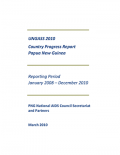
Resource | Publications,
At the United Nations General Assembly Special Session (UNGASS) held in 2001, 189 Member States adopted the Declaration of Commitment on HIV/AIDS; and PNG was among these States that initially adopted this Declaration. Every two years member states are required to report to the UN General Assembly, a on their progress towards achieving the goals of the 2001 Declaration of Commitment on HIV/AIDS and the 2006 Political Declaration on HIV/AIDS. The first UNGASS reporting round was in 2004. PNG submitted its first UNGASS report in 2008.
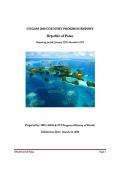
Resource | Publications,
This report was compiled by the Monitoring & Evaluation Officer of the HIV/AIDS & STI Program with the assistance of the Secretariat of the Pacific Communities. Consultations with staff members from the Ministry of Health, Finance and Budget Office of the Ministry of Health, Palau Red Cross Society, and the National Advisory Group on HIV/AIDS known as the Palau HIV/AIDS and STI Advisory Group (PHASAG) were held. The PHASAG meets 4-6 times a year and has played an active role in reviewing the HIV/AIDS & STI Program budget. They were actively involved in the workshop for reviewing the national HIV/AIDS & STI strategy in November 2007. Relationship between government and civil society has improved through increased collaboration and involvement in key areas of HIV/STIs. Due to the small population, the members of PHASAG are all involved in various boards and other organizations; however, the group had always garnered quorum to conduct its business.

Resource | Publications,
The process of UNGASS report preparation began in early 2010, with a request from the FSM National HIV/AIDS Coordinator to each of the state level HIV/AIDS/STI program managers to begin collecting relevant information to prepare an update of the 2008 report. The four state managers, assisted by their staff collected the information necessary to be included in the National Composite Policy Index (NCPI), the National AIDS Spending Assessment (NASA), and any other specific information required for the UNGASS report.

Resource | Publications,
The process of stakeholder consultation to participate in the compilation of the Country Progress Report on HIV in the Republic of the Marshall Islands (RMI) began in August 2009 when the UNAIDS Pacific Office, in collaboration with the RMI Ministry of Health’s Clinical Care Manager for the STD and HIV & AIDS Program, convened a Pre‐Planning Meeting to explain the purpose and process for compiling the UNGASS Country Progress Report on HIV. Up to 30 different government and civil society stakeholders were invited to the meeting to identify their contribution to the Report.
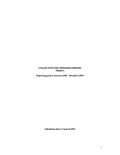
Resource | Publications,
The Maldives commenced UNGASS report preparation at a very late stage. Since Maldives has very little or no experience in UNGASS reporting, request for technical assistance was sent to UNAIDS, and UNAIDS supported by providing two external consultants to facilitate data collection and drafting of the narrative report. A working group was formed with representative of government (health and other sectors), civil society including NGOs / CBOs and UN agencies to prepare the report.
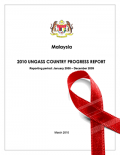
Resource | Publications,
Malaysia initiated the process of consultation in preparation of the 2010 UNGASS Country Progress Report in early November 2009. It was a matter of priority and concern for both the Government and civil society partners that this report would be able to capture as much of the opinions and viewpoints of not only that of the Government but most importantly those of the many civil society stakeholders in the response to HIV in Malaysia.
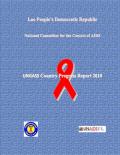
Resource | Publications,
Lao People’s Democratic Republic is unique in its HIV situation, and can be considered as the only country in the Greater Mekong Region that has maintained a low HIV prevalence in the general population. However Lao PDR’s low prevalence does not mean low risk. As Laos’ commitment to economic expansion transitions the country from “a landlocked to a land‐linked country” the risk to HIV vulnerabilities is evident. Increased mobility across borders coupled with the existing sex worker‐client vulnerabilities and the several emerging high‐risk groups, places Lao PDR on a continued alert of a new HIV threat.
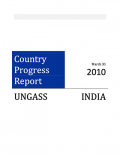
Resource | Publications,
India’s response to the changing nature of the epidemic is reflected in the policy framework and approaches of the National AIDS Control Programme. The third National AIDS Control Programme Strategy and Implementation Plan (2007-2012) is based on and builds upon the lessons learnt and achievements made in Phase I and II. The CPR India 2010 presents an overview of the epidemic, the strategic national response and its impact, and the challenges that lie ahead. India is a large diverse country and the epidemic is concentrated in six states among high risk populations. Complex social issues and entrenched social positions pose significant challenges for the policy makers, donors and the civil society engaged contributing to the national response.

Resource | Publications,
A working group managed the preparation of this country report. Its members were drawn from government (MOH, Fiji School of Medicine), non-government (Men Fiji, MSIP, PC&SS, SWAN) and multilateral agencies (UNAIDS, UNDP, WHO and SPC). The working group was established in June 2009 and confirmed the process and schedule for reporting. The working group communicated by email through 2009 and met regularly during the first quarter of 2010 to oversee the process of report development.





